Compost is one of the most valuable resources for beautifying your landscape,
and it is virtually free. The leaves you rake, the grass you mow, and the
branches you trim are some of the ingredients you can use to make compost.
Finished compost is dark and has a pleasant smell. It is produced when organic
matter, such as garden, lawn, and kitchen waste, is broken down by bacteria and
fungi.
Use it throughout your landscape- till it into gardens and flower beds, add
it to the soil when renovating your lawn, or sieve it and use it in potting
soil.
Return to Table of Contents
The Compost Bin
A compost pile can be as plain or fancy as you want - you don't even need a bin
to make compost. But if you plan to produce compost regularly, consider a
permanent compost bin. For convenience and aesthetics, you can choose from
numerous commercial compost bin or construct your own from wooden planks,
concrete blocks, used freight pallets, hardware cloth, or chicken- wire.
Before purchasing a commercial compost bin, determine if it will work
effectively in your landscape. It should be well built, economical according to
your needs, easy to assemble, and have easy access for turning the compost. It
should also be large enough to handle all the leaves in your yard.
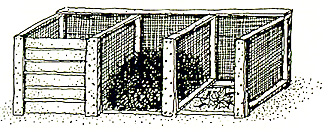
Some gardeners build separate bins for each stage of he compost process-one
for fresh plant refuse, another for the actively composting pile, and a third or
the finished compost. When building your own bin, keep one side open for easy
access. Also, leave spaces between blocks or planks for aeration- air is
essential to the rapid decay of organic materials.
The size of the compost pile determines how effective it will be; piles
smaller than 27 cubic feet (3x3x3) do not hold sufficient heat for the
composting to be effective, and piles larger than 125 cubic feet (5 x 5 x 5) do
not allow sufficient oxygen to reach the center. Be sure your compost pile is a
manageable size.
Compost barrel is another
way to use recycled used wine barrel to compost your yard and household waste.
The barrel was designed to rotate making your job easier and the steel rod
within will stir the content helping the process.
Return to Table of Contents
-
The carbon/nitrogen ratio: A mixture of dry leaves, sawdust, or other
sources of carbon combined with manure, green plants, or fertilizer for
nitrogen (approximately 4:1 by volume).
-
The oxygen level: A compost pile should be turned periodically to promote
decay of its contents. Turning the pile adds oxygen, so the more you turn
it, the faster it breaks down. (Turning heavy, rotting leaves and grass is
vigorous exercise!)
Return to Table of Contents
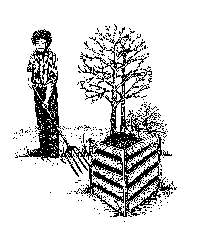 Locate your compost pile on a well-drained site which would benefit from
nutrients running off the pile. Your pile can be built gradually in layers and
then turned to mix. Or if you have sufficient material, it can be mixed and
blended at one time.
Locate your compost pile on a well-drained site which would benefit from
nutrients running off the pile. Your pile can be built gradually in layers and
then turned to mix. Or if you have sufficient material, it can be mixed and
blended at one time.
-
To ensure good aeration and drainage, put down a 3- inch layer of coarse
plant material, such as small twigs or chopped corn stalks, or a wooden
pallet.
-
Next, add about 8 to 10 inches of leaves or other dry organic wastes from
your landscape and/or kitchen.
-
Provide nitrogen for compost-promoting microorganisms by adding 2 to 3
inches of fresh grass clippings or fresh manure. If fresh nitrogen sources
are unavailable, add about one-third cup synthetic fertilizer (36-0-0) per
25 square feet of surface area.
-
If no soil is included in your compost material, add a sprinkling of soil
or a compost starter to each layer to inoculate the pile with
microorganisms.
-
Moisten the pile as you add leaves and other dry material.
Mix the materials thoroughly. Shape the pile so its center is lower than its
sides, to help water flow into the pile. Keep the pile moist, but not soaking
wet. Within a few days, it should heat up. If not, it may lack nitrogen or
moisture. If the pile emits an ammonia smell, it is too wet or too tightly
packed for oxygen circulation; turn the heap and add coarse material to increase
air space. Once a month, turn the pile with a pitch fork, putting the outside
materials on the inside and vice versa.
The plant materials should decompose into compost within five months in warm
weather, longer under cool or dry conditions. The center of the pile should
reach 160 degrees F to kill most weed seed, insects and eggs, and disease
organisms. Composting may be completed in one or two months if the materials are
shredded, kept moist, and turned several times to provide good aeration. Spread
it in the garden and dig or till it under to offer your soil and plants renewed
vigor.
Return to Table of Contents
Grass clippings and fall leaves are abundant compost materials for most
homeowners. Weeds free of seed heads and crop residues, such as vines and
leaves, are other sources. Never include weed seed or perennial roots or stems
that might become established. Collect vegetable and fruit peelings, coffee
grounds, crushed eggshells, and similar kitchen waste for your compost pile. Don't
use meat waste; it attracts animals. Acquire additional materials, such as
sawdust, manure, hay, or straw, from sources such as stables and carpenter
shops.
Return to Table of Contents
-
Composting in your backyard recycles wastes which might otherwise fill up
landfills. Leaves, grass, and debris- often raked into the street for
collection- tend to clog storm drains and street gutters and are costly to
collect. but make excellent compost materials.
Return to Table of Contents
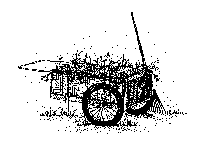 America is rapidly running out of landfill space. Consequently, we must make
our old landfills last longer. One way to do this is to compost yard and kitchen
wastes, which comprise an estimated 20 percent of the refuse going into our
landfills. Homeowners who compost not only extend the lives of landfills, but
also reduce costs for collecting organic debris. Also, composting recycles waste
to create a valuable soil amendment.
America is rapidly running out of landfill space. Consequently, we must make
our old landfills last longer. One way to do this is to compost yard and kitchen
wastes, which comprise an estimated 20 percent of the refuse going into our
landfills. Homeowners who compost not only extend the lives of landfills, but
also reduce costs for collecting organic debris. Also, composting recycles waste
to create a valuable soil amendment.
Return to Table of Contents
![]() Gardeners' Corner
Kids'
Garden
Sustainable Garden
Contact Us
Gardeners' Corner
Kids'
Garden
Sustainable Garden
Contact Us![]()
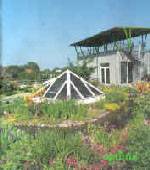

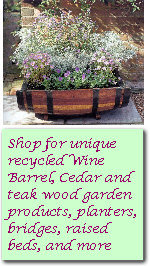

 Locate your compost pile on a well-drained site which would benefit from
nutrients running off the pile. Your pile can be built gradually in layers and
then turned to mix. Or if you have sufficient material, it can be mixed and
blended at one time.
Locate your compost pile on a well-drained site which would benefit from
nutrients running off the pile. Your pile can be built gradually in layers and
then turned to mix. Or if you have sufficient material, it can be mixed and
blended at one time.  America is rapidly running out of landfill space. Consequently, we must make
our old landfills last longer. One way to do this is to compost yard and kitchen
wastes, which comprise an estimated 20 percent of the refuse going into our
landfills. Homeowners who compost not only extend the lives of landfills, but
also reduce costs for collecting organic debris. Also, composting recycles waste
to create a valuable soil amendment.
America is rapidly running out of landfill space. Consequently, we must make
our old landfills last longer. One way to do this is to compost yard and kitchen
wastes, which comprise an estimated 20 percent of the refuse going into our
landfills. Homeowners who compost not only extend the lives of landfills, but
also reduce costs for collecting organic debris. Also, composting recycles waste
to create a valuable soil amendment.